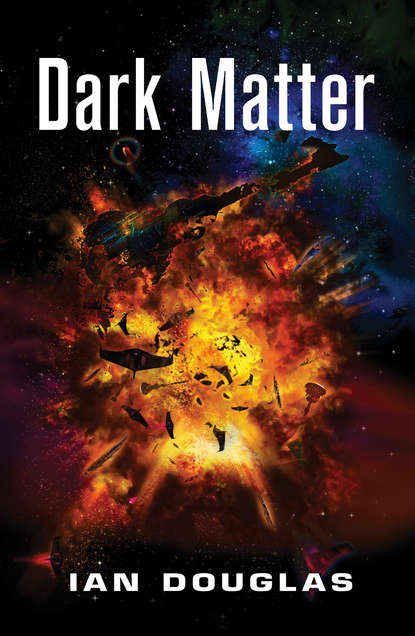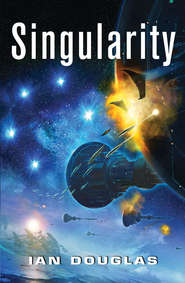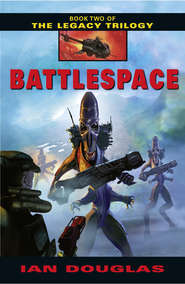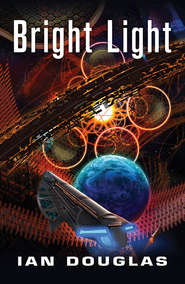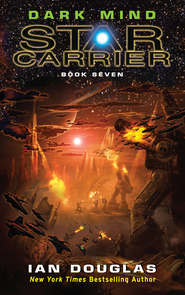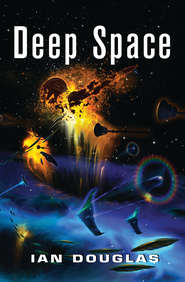По всем вопросам обращайтесь на: info@litportal.ru
(©) 2003-2024.
✖
Dark Matter
Настройки чтения
Размер шрифта
Высота строк
Поля
What, Gray wondered yet again, were the Rosette Aliens up to? Who were they? Where—when—did they come from? Were they Sh’daar? Transformed and transfigured ur-Sh’daar? Or someone, something utterly and completely different?
The stargods? It was as good a name as any . . . though the term Rosette Aliens, for now, carried less emotional baggage for the merely human observers on board America and her consorts.
Gray checked the time. Walton’s Shadowstar should be approaching the Rosette fairly soon, now. And if Walton survived the flight, they just might learn something more about exactly what the Rosette Aliens were up to.
Recon Flight Shadow-One
Omega Centauri
1118 hours, TFT
Lieutenant Walton was decelerating now, his Shadowstar flipped end for end so that he was slowing from very nearly the speed of light. He needed to be moving at a more sedate pace if he and the ship’s AI were actually to see and record anything as they made their close passage of the Rosette. He couldn’t see much at all right now. He’d reshaped the drive singularity forward to extend a stealth sheath aft over his fighter. From most angles, now, his Shadowstar was invisible, the light coming from space around him sliding around the craft without ever quite reaching it. As camouflage, it was moderately effective, though instruments and organic eyeballs might still see a distortion of the background stars as he slid past—and the rapidly flickering gravity well of his drive singularity was, as always, a dead giveaway.
So far, though, the Rosette Aliens hadn’t appeared to notice him. That . . . or they didn’t care.
He found the thought disturbing, akin to the thought of humans paying no attention to an ant crossing the path in front of them.
But if one of those humans chose to bring his foot down just so . . .
“I recommend dropping the sheath,” his AI told him. “We are approaching our objective.”
“Do it,” Walton said. “Let’s see what we have.”
He braced himself . . . and just in time. The sheath fell away as the artificial intelligence running the Shadowstar reconfigured the drive singularity, and the dazzling light of the heart of a globular cluster flooded in.
Millions of stars crowded one another across the spherical interior of that radiant sky. Streaks of blackness showed where the Rosette Aliens had been busy at their enigmatic work of demolition and construction. Visible, too, was the tangle of structures created over the past few months by the aliens, an incredibly vast spider’s web of pale blue light apparently anchored on and within the encircling stars.
Ahead and to starboard, a cluster of spheres hung adrift in space, each gleaming silver and as reflective as liquid mercury. And to port: the Black Rosette.
Whirling about their common center of gravity at 26,000 kilometers per second, the six black holes themselves were little more than a circular blur. Gas and dust streamed in from surrounding space, encircled the Rosette in a tight spiral radiating far into the short end of the electromagnetic spectrum and filling the sky with actinic blue-violet light. Hard radiation glared from the annihilation of infalling dust. This was, Walton thought, an extremely dangerous place to be. His ship’s shields would hold off the radiation for a time, but not indefinitely.
Walton’s Shadowstar was drifting rapidly across the face of that spiral, 100,000 kilometers away from the central maw. The expanse of space haloed by the rotating singularities revealed a starscape beyond, but not the vista of the Omega Centauri cluster.
He glimpsed a starfield . . . but one far thinner and poorer than that of the interior of the cluster. That scene was replaced in an instant by utter strangeness, by twisted and entangled streamers of red and gold and blue, the heart, possibly, of a nebula . . . or just possibly something else entirely, something beyond human experience. After that, more starfields, coming in rapid succession, and then a vast and mottled expanse of deep red-orange glare . . . the surface, he thought, of a red sun, a red dwarf, possibly, seen at close range. More starfields . . . and a panorama that seemed to show a spiral galaxy tilted sharply on end . . . and then a blast of blue light and hard radiation—a supernova, perhaps—or, again, something for which human astrophysics had no name.
Walton had the distinct impression that the scenes revealed within the Rosette changed as his angle of sight changed. There were myriad distinct paths through that gravitationally tortured gateway . . . that rip in the fabric of spacetime itself, and he was glimpsing hundreds of them as his Shadowstar fell across the Rosette’s maw. So fascinated was he by the succession of alien vistas that his AI had to give him the warning.
“We have elicited a response from the Rosette Aliens,” the Shadowstar’s artificial intelligence announced, its mental voice as calm and dispassionate as a netfeed announcement of next week’s weather over Omaha. “Directly ahead.”
Walton jerked his attention from the Black Rosette, and turned it instead to a bright silver star moving now into his recon ship’s path. He enhanced the magnification, zooming in on a perfectly reflective sphere that did not register on radar or any of his other sensors, save those recording the visible portion of the electromagnetic spectrum. He couldn’t even guess at the range or size of the thing. It might have been a meter across and a hundred meters away, or a kilometer across and much, much farther away. Since it was visible, a laser pulse would have given him a precise range . . . but a laser pulse might be interpreted as an attack.
Walton’s orders were specific: Do not provoke the aliens; do not initiate a hostile exchange.
He wished the aliens themselves had received those orders. According to the guys and gals in America’s intelligence department, they’d vaporized an unarmed survey vessel a few months ago, along with two escorting destroyers. That sounded like a pretty solid initiation of hostilities to him.
But the scale and scope of the stellarchitecture visible now around the Rosette gave some pretty convincing testimony about the aliens’ technological abilities, suggesting that nothing the human squadron could do would pose a particular threat to them.
The target ahead was growing steadily brighter. Since the thing appeared to be reflecting ambient light from the surrounding stars rather than glowing with its own, that suggested that he was closing with it.
“Engage drive,” he told the AI. “Let’s end for end and scoot.”
“That is not possible,” the AI replied.
“Why the hell not?”
“Unknown. Attempts to initiate singularity projection have failed. The Rosette Aliens may be manipulating local space in such a way as to damp out such attempts.”
“Shit! What about the power tap?”
The Shadowstar’s power plant was a scaled-down version of the power taps on board America and all other human starships. Microscopic artificial black holes rotated around one another on a subatomic scale, liberating a fraction of the zero-point energy available in hard vacuum at a quantum level. If the aliens had damped out his drive singularity, his power plant would have been affected too.
And yet, his in-head instrumentation showed a steady flow of energy.
“Ship power tap is functioning at optimum,” the AI told him.
“Can you explain that?”
“No . . . other than to suggest that the Rosette Aliens are damping out a very small and very specific volume of space immediately ahead of the ship.”
Walton had no idea how such a thing could be accomplished. An old, old phrase from the literature of some centuries before came to mind, a phrase suddenly sharply relevant. “Any sufficiently advanced technology is indistinguishable from magic.” He didn’t remember where the quote was from, and didn’t have the time now to look it up. He planned to do so once he got back to the America.
If he got back to the America. The silver sphere ahead was now rapidly growing larger, approaching him at high speed. His AI flashed a full update back to the carrier group.
And then the sphere, the encircling walls of brilliant stars, the mysterious and bizarrely twisted alien structures, the gaping maw of the Rosette, everything smeared halfway around the sky before winking into blackness. . . .
Chapter Two
20 January 2425
Recon Flight Shadow-One
Omega Centauri
1122 hours, TFT
. . . and then exploded into visibility once more.
Walton blinked. America hung in space 10 kilometers directly ahead. An instant before, he’d been almost 50 astronomical units away from the carrier . . . a distance of 7.5 billion kilometers, drifting at a velocity of a kilometer per second. Now he was traveling at the same speed, but his course had changed 180 degrees, and somehow he’d leaped across 50 AUs in an instant, and without accelerating to near c.
He remembered the way the sky had smeared around him, as though the space through which he’d been traveling had been bent through 180 degrees. And an instantaneous jump of 50 AUs? That was simply flat-out impossible. Even at close to the speed of light and subject to relativistic time dilation, he would have experienced some time making a passage that long . . . and fighters were too small by far to mount the drive projectors necessary for the faster-than-light Alcubierre Drive.
Alien magic. . . .
Working through his AI, which with a machine’s tight focus seemed unsurprised by any of this, Walton decelerated, drifting into America’s inner defense zone. “America!” he called. “America, this is Shadow One!”
There was a real danger that the carrier’s automated defense systems would target the incoming fighter and destroy it. The Shadowstar’s IFF should have flagged him as friendly on America’s scanners . . . but Walton found himself nursing a profound mistrust of the technology. Right now, the universe didn’t appear to be functioning the way it should.
And the recon fighter should not have been able to simply drop inside America’s defensive perimeter that way. It not only violated the rules and regs of combat operations . . . but it violated the laws of physics as well.





